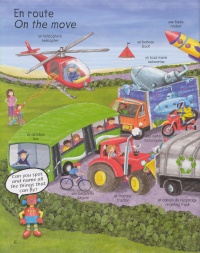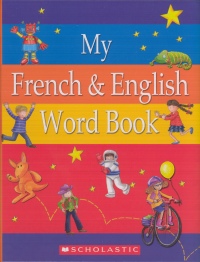| ________________
CM . . . . Volume XVIII Number 3 . . . . September 16, 2011
Originally published as the Oxford First Picture Word Book, this Canadian edition comes with dual-language text in order to appeal to children who are either bilingual or who are learning French as a second language. Essentially a simplified version of a picture dictionary, or what in French is called an imagerie, it consists of dual-page spreads featuring a busy scene, such as a cutaway of a home or a crowded highway, with bilingual lists of words associated with the theme, each with its own small image to make recognition easier. 
For young children, it makes an excellent book to share with their parents over and over again because it facilitates learning of vocabulary, word recognition, and pre-reading skills in a fun way. As the introduction indicates, there are many ways it can be used – kids can search for each object, answer the exploratory question featured on each spread, guess the word in the other language, and even search for the chameleon hidden in each picture. The pictures, themselves, are not terribly artistic but are suitably colourful, folksy, and charming. The only drawback to the book is the translated element. While the French is error-free, and shows no sign of favouring European usage over Canadian, there are a few places where translation intrinsically creates an awkward situation. In the dress-up scene, the kids are identified by what they are dressed up as – astronaut, nurse, etc. By necessity, the French chooses to use the gender of the child dressed up as the gender of the occupation. That isn’t a problem for un prince (masculine) or une cowgirl (feminine) because that is consistent with the gendered English terms, but it seems a little odd for un cuisinier (masculine) or une policière (feminine) as non-French speakers might assume those are the only words for “cook” or “police officer”. Similarly, a chart of commonly-used words gives unsatisfying French equivalents (e.g. going=va; to=chez; we=nous as well as we=on) – fine if you take only one language, but misleading for non-French speakers. Finally, a few elements, such as the questions, are not translated at all – making this a slightly imperfect but ultimately worthwhile book for all but unilingual Francophone families. Recommended. Mark Todd Kyle is the CEO of the Newmarket Public Library in Ontario and vice-chair of the Canadian Children’s Book Centre.
To comment
on this title or this review, send mail to cm@umanitoba.ca.
Copyright © the Manitoba Library Association. Reproduction for personal
use is permitted only if this copyright notice is maintained. Any
other reproduction is prohibited without permission.
NEXT REVIEW |
TABLE OF CONTENTS FOR THIS ISSUE
- September 16, 2011.
AUTHORS |
TITLES |
MEDIA REVIEWS |
PROFILES |
BACK ISSUES |
SEARCH |
CMARCHIVE |
HOME |
